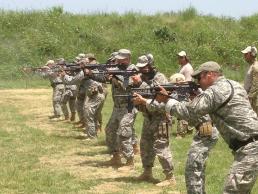Story by: Sgt. Josiah Pugh
Posted: December 8, 2013
 Courtesy Photo
Courtesy Photo
Soldiers from Special Operations Detachment - Africa (SOD-A), Texas Army National Guard, conduct reflexive fire training with the M4 carbine at Camp Bullis, Texas, June 2013. This training exercise helps maintain individual force protection readiness for the unit's future deployments to Africa in support of Special Operations Command-Africa, whose goal is to promote regional stability in that region. (Photo by Maj. Duncan Smith, SOD-A).
AUSTIN, Texas - For the first time in the Texas Army National Guard’s history it has a joint special operation’s detachment. The Special Operations Detachment – Africa (Airborne) (SOD-A) is one of eight such units belonging to the National Guard nationwide and was stood up in October of 2012 at Bee Caves Armory in Austin, Texas.
Their mission, to deploy overseas, lead and train both joint and combined special operations forces in support of theater campaign plans.
In the last year, SOD-A has recruited soldiers that will allow them to support their higher headquarters Special Operations Command-Africa whose goal is to promote regional stability in Africa and combat terrorism. About half of the soldiers in SOD-A are from a special forces background while the remaining members come from special operations forces, human resources, intelligence, logistics and signal backgrounds. soldiers in this unit travel from as far as California and Washington, D.C., just to attend their monthly drill.
Maj. Nathan Rettig, SOD-A Future Operations officer, said about the unit, “Getting a chance to support special operations in Africa was a long time goal, as I firmly believe special operations forces is an exponential force multiplier on the continent. Just as importantly, I knew and served with the high caliber individuals in this unit since we started the Texas Army National Guard Special Forces family in 2007.” Rettig added, “I know they are some of the most capable, experienced, and committed teams in the special operations forces community and I'm humbled and honored to serve with them."
In May, SOD-A participated in Epic Guardian, a joint staff-coordinated exercise focused on crisis action planning, deployment of forces and field operations. Aside from developing a partnership with Malawi, Djibouti and Seychelles, Maj. Duncan Smith, another SOD-A future operations officer, said the exercise provided much more to those countries’ militaries and militias. “We’re there to partner with the governments or militaries and offer an increased capability to provide a secure and stable region,” said Smith.
SOD-A provides a place for special forces or special operations soldiers in the National Guard where they can grow and advance their careers. Lt. Col. Douglas O'Connell, SOD-A commander, said, “The soldiers who have joined SOD-A are looking for a chance to conduct real world operations in challenging and extreme environments.”
Sgt. 1st Class Joshua Carter, training noncommissioned officer, has been with SOD-A since April of this year. “I can’t think of a better place for me and my future goals to be or a better environment where the mentorship is from the top down,” he said.
In late June, SOD-A conducted Sikorsky UH-60 Black Hawk airborne operation training and a reflexive fire with M4 carbine rifles and M9 pistols alongside Charlie Company, 1st Battalion, 19th Special Forces Group. In August, the unit conducted its first joint training partnership with the U.S. Navy Reserve SEAL Detachment 208, in a joint military decision making course in order to prepare for future deployments.
Spc. Vanessa Freitag, a personnel administrator, has been with SOD-A since March and found her comrades have been more than happy to include her in all their training.
“I love it,” said Freitag. “I think this has challenged me. I’ve grown with them. It’s such an invigorating experience being a part of this group because initially it was very intimidating. I wasn’t quite sure what to expect or what they expected of me and everything’s formed together, especially for a new unit. A lot of the guys are special forces and they’re not quite used to a staff unit, but we’ve meshed so well together. They’ve made me feel very welcome from the beginning.”
Lt. Col. Theo Unbehagen, Operations Officer, has been with SOD-A since October of last year and is excited to deploy to Africa. “It’s going to be a great experience I think, because we’re going to be in a different area,” said Unbehagen. “We’re going to be working with the partner nations, working, training with, learning from them and teaching them. It’s really rewarding.